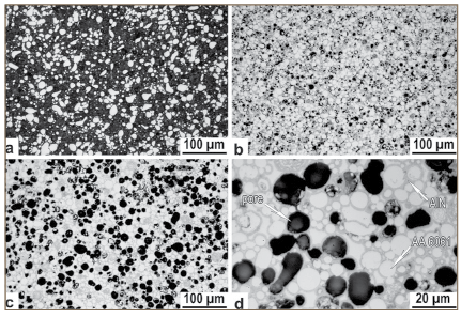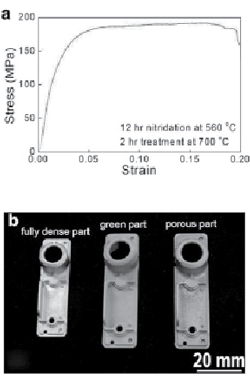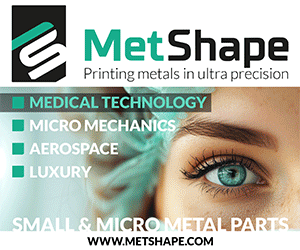MIM used to produce hollow sphere reinforced aluminium matrix foam parts
February 11, 2013
A new process using Metal Injection Moulding (MIM) to produce high porosity aluminium matrix composites (MMCs) by the in-situ forming of AlN hollow spheres in the matrix has been developed by researchers at the ARC Centre of Excellence in Light Metals, University of Queensland, Australia. The researchers, Peng Yu and Ma Qian, recently published details on the process used, and the properties of the resulting AlN hollow sphere reinforced Al MMC, in Materials Chemistry and Physics (online October 26, 2012).
The manufacturing process to produce the AlN hollow sphere reinforced Al MMCs involved first mixing grade Al 6061 aluminium powder (D50 = 13.4 µm) and 2 wt.% Sn (<43 µm) with a binder comprising stearic acid (3%), palm oil wax (52%), and high density polyethylene (45%). Powder loading in the feedstock was put at 62 vol%.
After injection moulding the green parts were subject to solvent debinding, and the resulting ‘brown’ parts had 38% porosity. This was followed by a two-stage sintering step where the parts were first heated to 560°C. During this step flowing nitrogen gas was introduced to create partial nitridation where each Al6061 particle in the compact reacts with the nitrogen to form an AlN shell enveloping the particle. After this step the furnace was switched back to vacuum and the temperature increased to 700°C to trigger an ‘open-closed pore transformation’ in the microstructure.

Fig. 1 SEM fractographs of fractured samples: (a) after sintering and nitriding at 560°C for 12 hr, and (b) after the ‘open-closed pore transformation’ at 700°C. (From paper: Metal injection moulding of in-situ formed AlN hollow sphere reinforced Al matrix syntactic foam parts, by . P.Yu and M. Qian. Published in Materials Chemistry and Physics, October 26, 2012)
The authors stated that both the Al 6061 core enveloped by each AlN shell and the Al 6061 matrix within it were found to have melted when the as-nitrided parts were heated to 700°C (above the liquidus of Al 6061, ~630°C) to trigger the ‘open-closed pore transformation’. This was said to be driven by a decrease in the interfacial energy of the system, where molten Al 6061 alloy spontaneously penetrated through the permeable AlN shell to fill the interstices outside. Consequently, the interstices between the partially nitrided Al 6061 particles, which were open pores prior to the transformation, were filled with solidified Al 6061 after fabrication, while many AlN shells become hollow structures with a spherical closed pore inside each.
The authors reported that both the Mg powder added to the supporting sand (Al2O3 – 2 wt.% Mg) and the Sn powder (2 wt.%) mixed into the Al 6061 powder played an important role in the partial nitridation process. The Mg powder is said to act as an oxygen getter to ensure a sufficiently low oxygen partial pressure for the formation of AlN, while the Sn controls the rate at which AlN forms. The formation of AlN and the limited sintering that occurs during partial nitridation reduces the porosity of the brown samples from ~38 vol.% to ~30%. They stated that the conventional MIM fabrication process was essentially finished by this step.

Fig. 2 An Al demonstration part with the
porous part on the right, green (middle),
and nearly full dense (left). (From paper:
Metal injection moulding of in-situ formed
AlN hollow sphere reinforced Al matrix
syntactic foam parts, by . P.Yu and M. Qian.
Published in Materials Chemistry and
Physics, October 26, 2012)
In the as-nitrided structures, AlN shells are interconnected, forming a rigid skeleton to impart strength to the sample, while the spaces outside the AlN shells are also interconnected, forming an open pore structure. SEM fractographs of fractured samples in Fig.1a show the microstructure after sintering and nitriding at 560°C for 12 hr; Fig.1b shows the structure after the open-closed pore transformation at 700°C. Pore size and pore size distribution are said to be closely related to the Al particle size and the fine powder used in this work gave micro-sized closed pores (~10 µm).
The researchers stated that these pore features would be difficult to achieve by other means. The in-situ AlN hollow sphere reinforced Al MMC exhibits a high compressive strength of ~200 MPa, which is superior to conventional Al MMC parts with pre-fabricated ceramic hollow sphere reinforcements.
Fig. 2 shows a demonstration syntactic Al foam part made using the new process. As can be seen the porous part made shows little sintering shrinkage compared to the green part. This is because the AlN shell structure formed in the part is present as a rigid AlN skeleton, which imparts strength to the part and prevents sintering shrinkage.
News | PDF Store | Magazine Subscriptions | What is PIM? | e-newsletter

















